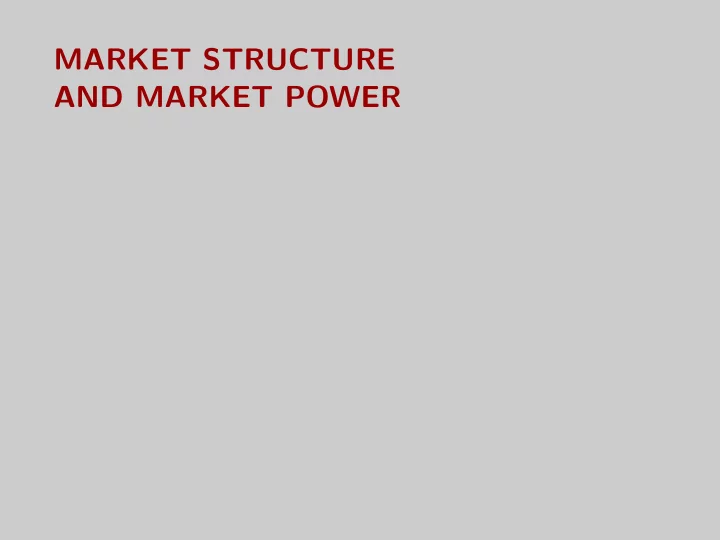

MARKET STRUCTURE AND MARKET POWER
Measuring market power • One firm: margin m = p − MC p • Many firms: average margin, a.k.a. Lerner index � n p − MC i L ≡ s i p i =1
Measuring market structure • n (number of firms), or 1 / n • C i index � 4 C 4 ≡ s i i =1 • Herfindahl-Hirsh index (a.k.a. HHI) � n s 2 H ≡ i i =1 • C 4 ∈ [0, 100] (or [0,1]), H ∈ [0, 10, 000] (or [0,1]) What do the extremes mean? • Pros and cons of each measure
Intensity of competition and market structure • Exhibit 1: pharmaceutical industry in Sweden − Each month, government auctions right to be main or sole supplier − Bertrand competition − Very high concentration: leading supplier takes from 50 to 70% market • Exhibit 2: banking industry in Kenya − Interest rates around 12%, no variation with respect to # competitors − Very little price price competition − High entry rates; currently more than 40 banks • Summary: higher degree of competition, more concentrated market
Intensity of competition and market structure • Suppose different countries only differ on market equilibrium price (e.g., regulation) • Cost function C = F + c q , entry cost E • Free entry equilibrium 1 n ( p − c ) D ( p ) − F = E • Solving for equilibrium � n � � 1 � n = E + F ( p − c ) D ( p ) • Hence, lower p (more intense competition) implies lower n (more concentrated market)
Market concentration and market power • In previous exercise, vary intensity of competition and find free entry equilibrium • Alternatively, fix degree of competition (specifically, Cournot) and vary market structure • It can be shown that L = H − ǫ where ǫ is price elasticity of market demand
Example • Consider two markets with identical demands − Market 1: two firms with identical market shares − Market 2: one firm with a 70% market share, two small firms with 15% each • Assuming Cournot competition in both markets, where is market power the greatest? • Answer: whichever market has higher HHI − Market 1: H = 50 2 + 50 2 = 5, 000 − Market 2: H = 70 2 + 15 2 + 15 2 = 5, 350
Structure-Conduct-Performance paradigm • Structure determines conduct − e.g.: collusion easier with fewer firms • Conduct determines performance − e.g.: Bertrand implies lower margins than Cournot • Structure determines performance − e.g.: fixing Cournot, L is proportional to H
Structure-Conduct-Performance hypothesis • Positive correlation between structure (e.g., H ) and performance (e.g., L ), where L is proxied by average profit rate r i ≡ R i − VC i = p q i − c i q i = p − c i = m i R i p q i p • Weak relation in empirical studies − poor data − cross industry comparisons: apples and oranges − reverse causality implies opposite correlation
Collusion v efficiency hypotheses • Suppose that feedback effects are unimportant: structure determines performance • Suppose higher concentration is correlated with higher profits (some evidence). What is source of correlation? • Collusion hypothesis: variation in degree of collusion • Efficiency hypothesis: variation in firm efficiency • Either hypothesis is consistent with aggregate correlation, but narratives and policy implications are very different
Recommend
More recommend